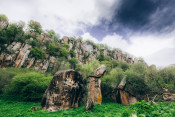
The Presidential Library invites to the exhibition of world-class showpieces
An exhibition of the Presidential Library named ““Protecting nature means protecting the native land”: for the Year of Ecology in Russia” is for the first time featuring the samples of seeds of cultivated plants from the world's largest collection, gathered by the foremost scientist and public figure of the XX century N. I. Vavilov. Currently this collection is the national treasure of Russia and one of the largest genetic banks of our planet.
Guests of the Presidential Library will get a chance to see the seeds of leguminous crops collected during the expeditions of Nikolai Vavilov and his followers. The expedition notebooks will help to find out about the amazing scientists’ travels. Among the unusual exhibits of the exposition are a cotton tree, wild watermelons, the samples of corn and pumpkin from Latin America. A special place in the exposition belongs to the camera of Nikolai Vavilov, which boar company with him during the expeditions. In addition, visitors will see rare archival documents, photographs of Nikolai Vavilov and his immediate scientific surrounding. Some of the exhibits are demonstrated for the first time outside the All-Russian Research Institute of Plant Industry named after N. I. Vavilov. These and other equally unique materials will remain for viewing at the exhibition of the Presidential Library up to February 22, 2018.
With the help of conventional and multimedia equipment, the exposition reveals the current problems in the field of environmental protection, tells about the natural resources of Russia and the ways of improving the ecological state of our country as an important part of the ecosystem of the entire planet.
It is not a mere coincidence that the Year of Ecology and the Year of Specially Protected Natural Areas have been chosen as the themes of 2017. January 11 marked the 100th anniversary of the first state national reserve in the history of Russia — Barguzinsky. It’s believed that from this very moment a creation of current Russian system of specially protected natural areas is being counted.
As is known, by the end of the XIX century the institute of forests protection was formed. In 1888, Emperor Alexander III adopted the “Regulations on forests conservation,” according to which, in order to save forests, the state was given a preferable right to purchase for national treasury, in agreement with the owners, protective, water conservation, forestless and forestry-important territories. A copy of this archive document is offered for examining at the exhibition of the Presidential Library.
The Russian Geographical Society has largely contributed into the nature conservation. Founded under its auspices in 1912 Permanent Environmental Protection Commission laid the foundations for protection the areas of natural heritage of Russia. Expeditions to Kamchatka, the Urals and the Baikal were organized to study these territories and to allocate sites for establishing the reserves. These expeditions came to the first in the country project of creation of a network of reserves, the most part of which was laid down already in the USSR by the middle of the XX century. Many territories were taken under protection according to the plan of the environmental commission. Copies of the documents from the case “On the Permanent Environmental Commission at the Imperial Russian Geographic Society” are presented among the exhibits.
A particularly important work on the conservation of biological diversity is an evaluation of the threat of extinction of certain species of animals and plants. In 1978 the first Red Book appeared in the USSR — a legislative document containing a list of animals and plants under threat of extinction. The exhibition presents the Red Books of the USSR, the Russian Federation and constituent entities of the Russian Federation.
It stands to mention that within the framework of cooperation with the Presidential Library, many regions of the Russian Federation joined arranging the exhibition and sent the electronic copies of their own Red Books from all over Russia. So, the visitors of the exhibition will get a chance to find out about the natural specifics of the Khabarovsk Territory, the Republic of Altai or the Sakhalin Region, to see the images of rare animals of the Khanty-Mansiysk Autonomous Okrug — Ugra, Kamchatka and many other territories.
Multimedia gear will let visitors to watch video footages about the natural resources of Russia. One of videos is dedicated to the Barguzin Reserve, the territory of which was included in the “Lake Baikal” World Natural Heritage Site in 1996. Owing to the photographs of the competition of the Ministry of Natural Resources of Russia entitled “100 years of the System of Reserves of the Russian Federation,” the guests of the Presidential Library will see high mountain peaks and river valleys with wide floodplains, taiga with centuries-old trees and steppes, alpine meadows, warm shallow bays and deep-water basins, the water temperature in which even at the surface do not rise above 15 degrees.
The partners of the exhibition are the Ministry of Natural Resources and Ecology of the Russian Federation, the All-Russian Research Institute of Plant Industry named after N. I. Vavilov, the Center for the Study and Conservation of Marine Mammals of “Vodokanal of St. Petersburg,” the Russian Geographical Society, the Russian State Historical Archives, the Library of the Russian Academy of Sciences, the Scientific Library of St. Petersburg State University named after M. Gorky, the Central City Public Library named after V. V. Mayakovsky.
Please, let us know if you plan to visit the exposition over the phone (812) 334 2514 or email: excursion@prlib.ru.





